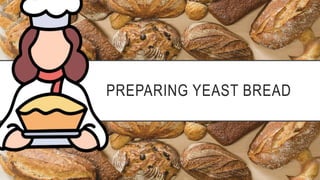
Preparing Yeast Bread- Ferrolino and Redoma
- 2. KEY CONCEPTS 1. Whatis a yeast bread? 2. Whatare thebasic ingredientsin makingyeast breads? 3. Types of yeasts 4. Stagesof yeast making 5. Ways in makingyeast bread
- 3. WHAT IS A YEAST BREAD? •Yeast bread are breads that uses yeast as a leavener. It comes in different sizes and shapes.
- 4. BASIC YEAST BREAD INGREDIENTS •Flour •Yeast •Water •Salt
- 5. • Flour gives structure to the product • Yeast uses the sugars and oxygen in dough to produce more yeast cells and carbon dioxide gas. The carbon dioxide makes the dough rise which gives the bread a light and spongy texture. • Water (liquid) helps carry flavorings throughout the product. It helps form the gluten bonds and reacts with the starch in the protein for a strong but light structure. • Salt strengthens gluten and enhances the flavor.
- 6. 3 TYPES OF YEAST • Compressed yeast -a fresh yeast that must be kept refrigerated to retain its moisture and freshness. It is considered active. Active dryyeastis the most common yeast and it differs from compressed due to the moisture being completely removed. This renders the yeast dormant and must be activated using warm water prior to combining. Instant dry yeast is popular due to its ease of use and is added directly to the dry ingredients without rehydrating. You can activate it using water if you so choose and many bakers do just that.
- 7. THE 12 STAGES OF YEAST PRODUCTION o Scaling the Ingredients o Mixing and Kneading the Dough o Fermenting the Dough o Punching Down the Dough o Scaling/Portioning/cutting the Dough o Rounding the Portions o Benching o Panning o Proofing the Products o Baking the Products o Cooling the Products o Storing
- 8. STAGES OF YEAST PRODUCTION 1. Scaling- Increasing and decreasing the yield prior to baking 2. Mixing and Kneading – the process of incorporating all ingredients to make a dough 3. Fermenting the dough – Fermenting is allowing the yeast to develop enough carbon dioxide to give rise to the dough.
- 9. STAGES OF YEAST PRODUCTION 4. Punching down the dough –punching out all the excess air that has built up inside the dough to remove cavernous air pockets that can affect the final baked product. 5. Scaling/Portioning/cutting the dough –portioning the dough into the sizes you desire. 6. Rounding the portions – The portions are then rounded into smooth, round balls to stretch the gluten that will help hold in the gasses and give a smooth surface.
- 10. STAGES OF YEAST PRODUCTION 7. Benching- let the dough rest to relax gluten 8. Panning- the shaped dough of your desire is put into a pan or mold where it will be baked in. 9. Proofing the products – the shaped portions are left to proof to allow the product to double in rise.
- 11. STAGES OF YEAST PRODUCTION 10. Baking the products – put the proofed dough in the oven for the final rise. 11.. Cooling the products- let it cool on racks so that moisture does not create a soggy texture in the crust. 12. Storing- Store at right temperature.
- 12. WAYS IN MAKING YEAST BREAD • TRADITIONAL PROOFING METHOD • ONE-BOWL MIXING METHOD • BATTER BREAD METHOD
- 13. TRADITIONAL PROOFING METHOD 1. Proof the yeast 2. Add remaining ingredients 3. Knead the dough 4. Proof the dough 5. Shape into loaves or rolls 6. Bake perfectly
- 14. ONE-BOWL MIXING METHOD • Measure and heat liquids to 120 to 130 degrees Fahrenheit. • Combine part of the flour, yeast, and other dry ingredients. • Add liquid to flour and yeast mixture and beat with electric mixer or by hand until a smooth batter forms. • Gradually add remaining flour, using a dough hook or by hand, until the dough becomes too stiff to stir. • Begin kneading the dough in a clean working surface sprinkled with flour.
- 15. • Place the kneaded dough in a greased and clean mixing bowl. Let the dough rise in a warm spot. • Punch down dough and let it sit for 10 minutes • Divide dough into pieces as called for in the recipe. • Bake as directed in the recipe.
- 16. BATTER BREAD METHOD • Batter breads are usually made in the same way as the one-bowl method, except less flour is used so the dough remains too sticky to handle. After beating in the required amount of flour, the dough is either ready to be put into greased pans, rise, and bake, or rises once before it's put into the pans.
- 17. REFERENCE S • Step by step yeast bread instructions and tips. (n.d.). The Spruce Eats. https://www.thespruceeats.com/step-by-step- yeast-bread-481242 • Discover the 4 basic yeast bread ingredients. (n.d.). The Spruce Eats. https://www.thespruceeats.com/yeast-bread- ingredients-478798 • How to make fresh bread: 10 easy steps for perfect bread. (2012, April 23). The Culinary Cook. https://theculinarycook.com/how-to-make-fresh-bread/ • 12 steps to yeast dough production. (2012, April 2). YouTube. https://youtu.be/sdKEtkm2ckw